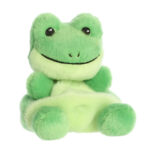Adopt A Frog!
The Puggle, our STEAMfest 2024 mascot, would like to introduce the Frog, our STEAMfest 2025 mascot!
Puggle is the name used to refer to a baby platypus. At STEAMfest 2024, we learned many fun facts about the Australian platypus and many of our visitors adopted their very own adorable plush puggle.
This year, at STEAMfest 2025, visitors can adopt our newest STEAMfest mascot and learn fun facts about frogs! Like the puggle last year, supplies are limited so reserve your froggy now!
This adorable frog is 5″ tall, has a bean-weighted bottom so it can sit upright, and is made of a soft green plush material. Whether sitting on your desk while you learn facts about the many varieties of frogs from around the world, are having naptime snuggles with your new pal, or tossing your froggy in the air, this little friend is ready for it all!
Each frog comes with a Certificate of Adoption for you to complete with your froggy’s name and date of adoption, as well as some cute Frog Facts it would like to share with you.
Your Froggy will be waiting for you at STEAMfest!
All proceeds go to support the STEAMfest mission.
Click the “Register Now” button and adopt your frog today as part of your STEAMfest 2025 preregistration!
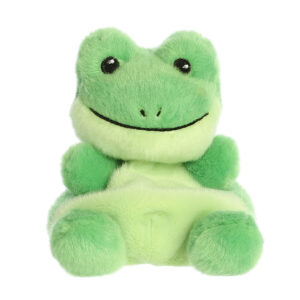
STEAMfest 2025 Mascots Have Arrived!
Frog Facts

Frogs are amphibians which are cold-blooded vertebrates that thrive in moist environments. Vertebrates means they have a spinal column or backbone. Cold-blooded means frogs need an external, or outside their body, heat source to keep them warm.
Humans, like you, and frogs are similar in that we both have backbones, but unlike the cold-blooded frogs, we are warm-blooded. Our bodies are able to keep us warm from the inside.
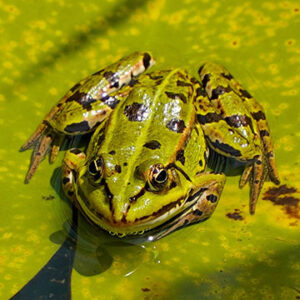
Except for one known species of frog, the Borneo, frogs breathe through their lungs. However, frogs also have mucus covering their bodies that allows them to breathe through their skin. The wet environments these amphibious frogs live in help keep their mucus covered skin moist and breathable.
So, frog can exchange oxygen and carbon dioxide through their lungs, like us. But, unlike us, their skin is covered in mucus and they can breath through it!

Metamorphosize is a big word that means to change forms. Frog metamorphosis happens during 4 stages of their life cycle.
Stage 1 of the frogs life cycle is the Egg Stage. Frog eggs are soft and jelly-like.
Stage 2 is the Tadpole Stage. Baby frogs hatch from their eggs as tadpoles. Tadpoles have gills like a fish and swim around using their tails.
Between Stages 2 and 3, is when the metamorphosizing begins. The tadpole begins to grow legs like a frog.
Stage 3 is the Froglet Stage. The tadpole’s tail begins to shorten and the young frog begins to look more like an adult frog.
Stage 4 is the Adult Frog Stage. The frog no longer has a tail and the metamorphosis is complete!
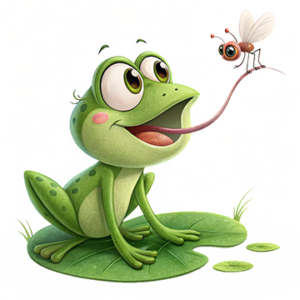
As tadpoles, frogs start out as omnivores, meaning they eat both plant and animal matter. However, most adult frogs are carnivores and carnivores eat meat! The meat of choice for lots of frogs are bugs. Some frogs have long sticky tongues that they use to catch flies, mosquitos, spiders, and such.
Some larger frogs might also dine on earthworms, small rodents, and even other amphibians like themselves!
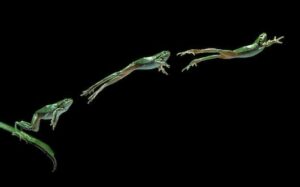
One might say frogs have Super Powers! Frogs can leap over 20 times their body length. That’s like you jumping across the length of a school bus in one jump! Those are some strong legs!
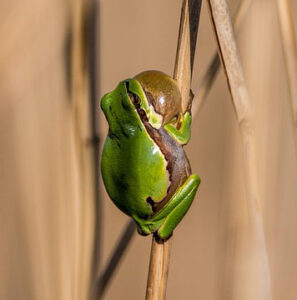
Ribbit is the word one might use to describe the sound a frog makes when it croaks, or makes noises. Like us, frogs have vocal cords that they use to communicate or talk. However, males do most of the talking, while most females remain quiet.
Frogs, unlike us, also have a vocal sac that amplifies vibrations or makes the sounds they produce loader. Have you ever sat outside on a warm summer evening and heard the frogs croaking? The sounds are sometimes so load you feel like the frogs might be next to you when in fact they may be as far as a mile away.
Frogs make sound by moving air back and forth from their lungs into air sacs located near their mouth or throat. They can produce sound without actually opening their mouth.
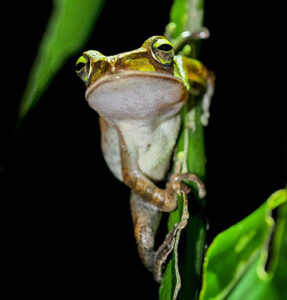
Frogs eyes are located on top of their heads. They appear large and bulging compared to our eyes. The location on the top of their heads and the large-bulginess of their eyes gives them a wide view of things around them. They can see almost all around them without moving their heads.
Frogs have 3 eyelids, an upper eyelid, a lower eyelid, and an eyelid called a “nictitating membrane”. The nictitating membrane keeps the eyes moist when not in the water and helps them to see underwater.
A frogs eyes also helps them swallow food. Blinking their eyelids, pushes the eyeballs into the roof of their mouth. This action helps push bugs and other prey down their throat.
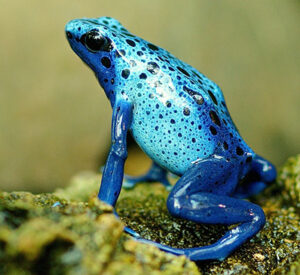
Some frogs are poisonous to humans and other animals. The brightly colored Dart Frogs of South America, for example, are among those poisonous to humans. Poisonous frogs release their poisons or toxins through their skin. This is how they defend off predators that might want to harm them. Even if the poisons released are not deadly, they may make other animals very sick.
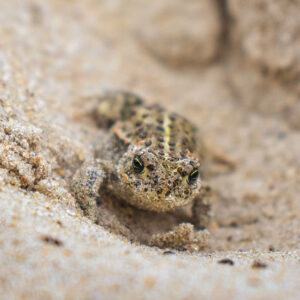
Frogs can be found all over the world! There are over 7,400 different species or types of frogs. We have them here where we live, but frogs can also be found in places like tropical rainforests, where it is warm and wet, deserts where it is dry and there is very little water, and the tundras where the temperatures can be freezing cold.
Frogs are very adaptable to the environments in which they live. We already learned about the mucus that covers their skin and keeps it moist when they are on land. But, desert frogs, for instance, form a protective wax coating over their skin that helps keep them moist when it is dry out. Other frogs, like those in the cold tundras, hibernate, or go to sleep, during cold spells. Some of our frogs hibernate and sleep through the winter too.
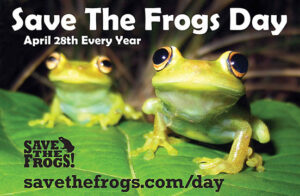
Let’s save our frog friends! The lives of frogs around the world are being threatened. Some frogs are becoming homeless because the habitats, the places where they live, are being destroyed. Lakes, streams, and other wetlands are being destroyed. Some are being threatened due to pollution that poisons them. Others are being threatened by diseases that are being spread. Unfortunately, some types of frogs have already gone extinct, meaning we can no longer find any of them living.

